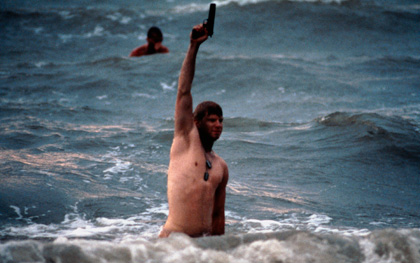Primary navigation


Michael Atkinson hails Terrence Malick’s elegiac, mainstream-defying war epic, now given the Criterion treatment with extras that clear up a little of the mystery – and add to the mythology
The Thin Red Line
Terrence Malick; US 1998; Criterion / Region 1 NTSC; 171 minutes; Aspect Ratio 2.35:1; Features: outtakes, interviews, audio commentaries, vintage newsreels, audio samples of Melanesian chants, original trailer, essay by David Sterritt, reprinted essay by James Jones
There is little dispute any longer about the pre-eminence and magical stature of The Thin Red Line, famous at first for being Terrence Malick’s long-awaited return from his 20-year void of Pynchonesque coverture and then for being a mainstream-defying non-narrative art film made on the Hollywood dime, and then for being merely the semi-ignored eccentric twin to the mainstream golden boy of Saving Private Ryan (the domestic box-office ratio in 1998 between them was six to one). Awake viewers knew immediately what they had: an epic Whitmanesque lyric, using Guadalcanal and the Pacific War as a defiantly free-associative brood on man’s fraught relationship to nature. Its greatest achievement, arising from the weft of cutaways, dreamtime soundtrack reveries, found phenomena, disconnected combat episodes and explicit metaphysical inquiry, is the creation of a cinema with a truly communal voice, a portrait of humankind not refined down to individuals and story. In a medium that relies so heavily on circumstantial viewer-protagonist empathy, we’re tied to no one figure in the flow of Malick’s movie, and yet we’re one with them all. As the multi-voiced narration says over and over in different ways, and in this case by way of Jim Caviezel’s Private Witt, “Maybe all men got one big soul everybody’s a part of, all faces are the same man.”
In some ways a manner of reimagining Wim Wenders’ Wings of Desire but without the angels, Malick’s everyone-is-Everyman approach certainly makes The Thin Red Line the most radical American film ever to be nominated for a best picture Oscar. But the film, emptied of traditional screenplay clockwork, fills itself up with an elegiac, epiphanic sympathy that makes it feel closer in spirit to a Philip Glass opera or Vaughan Williams cantata or even a Kazantzakis epic. After nearly three hours of this gentle scouring, even the unwilling viewer emerges burned by the film’s rocket of heartbreak.
It doesn’t need selling, a dozen years later, and neither does the new Criterion disc, with a pristine new digital transfer that is virtually essential. Just as vital is the phalanx of interviews and making-of descriptions, because Malick’s film has always been a mysterious creature – how did he get this made, with this cast? Rumours have long abounded (begun, in more than one case, by actors edited out of the final film) that Malick started with a straight-narrative adaptation of James Jones’ novel, with Adrien Brody’s Fife as the main character, and then, when told to cut it from five hours to three, tossed away most of the orthodox story. (As it is now, Brody has only a few, mostly mute minutes of screen time.) The hubris required echoes that of Jean-Luc Godard, who, when told by the producer of Breathless to edit a half-hour from the movie, changed cinema history by simply scissoring out everything he found orthodox and dull, including transitions and expository scenes. Imagine if the producer had been satisfied with Godard’s two-hour version.
But in terms of The Thin Red Line the theory is put to rest, as the actors (including Jim Caviezel, Sean Penn and Dash Mihok), the casting director and most tellingly the three editors all vouch for Malick’s whimsical methods at work from pre-production onwards – he never intended to make a straight-on war film, no matter what his huge original screenplay said. According to witnesses and co-workers, from the outset Malick led his team like some kind of dreamy, stoned impresario-king, whimsically improvising and keeping the entire mammoth production open to happenstance and accident. Apparently, some scripted scenes had often no specific characters – Malick would decide which actor would be featured at the last moment, and inform them minutes before shooting. He’d spend days wandering around behind the actors, telling them to make dialogue up, and often to say nothing at all. If he found beautiful natives doing fascinating things, he’d stop everything and shoot them. To hear the interviewees talk, Malick remains a mystery to almost everybody, even for personnel who’ve spent years working with him. On location, the actors could ask him about their roles, or about the movie in general, but, according to Penn, “He’ll answer you, but it doesn’t help.”
If only big budgets fell to such artists more often – imagine the miracles. The film’s mythology is also inflated by the footage left out – Gary Oldman, Viggo Mortensen, Bill Pullman, Martin Sheen and Lukas Haas all shot scenes but were dumped. Included amid the outtakes (too few – Malick shot over a million feet of film) is the notorious Mickey Rourke scene, the loss of which Rourke has grieved publicly. Criterion gives us a glimpse – Caviezel’s Witt confronting Rourke’s bush-traumatised grunt in the wilderness – and it’s easy to agree that the scene should’ve been included, woven into the magic carpet. Given the loose-knit texture of the film, it’s difficult not to crave more, and a director’s cut that restores the fabled material, at whatever length, is possible. But the film’s editors report that they had a hard time getting Malick to even watch his own film during post-production, and it seems obvious that persuading him to go back and work up another version out of the heap of celluloid would be like trying to herd cats.
Bayonets in paradise: Terrence Malick’s preference for nature and myth over history tarnishes his rich come-back epic The Thin Red Line, argues Colin MacCabe (February 1999)
The Thin Red Line reviewed by Geoffrey Macnab (March 1999)
Popcorn patter: David Thomson rediscovers Malick’s re-released debut Badlands, a hymn to the lost West and a brutal dissection of the American dream(September 2008)
The New World reviewed by Amy Taubin (February 2006)